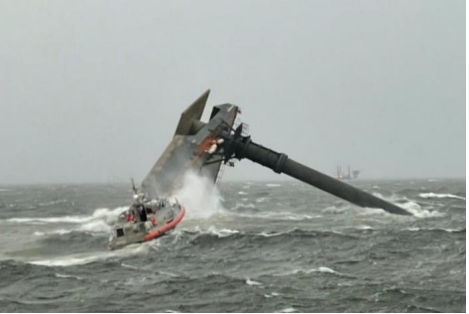On April 13, 2021, the liftboat Seacor Power made its way into the Gulf of Mexico from Port Fourchon, La., headed for an offshore rig owned by Talos Energy. In route, the boat motored into a storm and Seacor Power capsized. Six out of the 19 onboard the vessel owned by Seacor Marine were rescued, the rest are dead or remain missing. Among the dead was the boat’s captain, David Ledet.
A small but intense low-pressure system, known to meteorologists as a wake low, passed through the area on the afternoon of the incident, creating hurricane-force winds of 80-90 mph and seas offshore of 7' to 9'. Though bad weather had been forecasted, the intensity of the storm took everyone by surprise.
At about 3:30 p.m. on the afternoon of the 13th, as the Seacor Power transited the open waters of the Gulf, a squall passed over the liftboat. With visibility dropping and winds increasing significantly, the crew decided to lower the liftboat’s legs to the seafloor to hold the vessel in position until the storm passed. The crewmember at the helm attempted to turn the liftboat into the wind as the legs began to descend. Before the turn was completed, the liftboat heeled to starboard and capsized.
Severe winds during a thunderstorm led to a loss of stability and ultimately the capsizing of the liftboat, the National Transportation Safety Board said Tuesday during a public board meeting. Of the 19 people aboard the vessel, six died and seven are missing, presumed dead. Six people were rescued by the U.S. Coast Guard and other vessels. The Seacor Power, valued at $25 million, was a total loss.
Coast Guard hearings into the incident were held in Houma, La., in August 2021. The testimony from those that survived the tragedy was gut wrenching at times. NTSB was part of those hearings. The public docket for the investigation includes more than 10,000 pages of factual information, including interview transcripts, a meteorology report and other investigative materials.
A National Weather Service report concluded the area of the capsizing was affected by an “unusually intense thunderstorm wind event.”
The NTSB determined the probable cause of the capsizing of the Seacor Power was a loss of stability that occurred when the vessel was struck by severe thunderstorm winds, which exceeded the vessel’s operational wind speed limits. Contributing to the loss of life on the vessel were the speed at which the vessel capsized and the angle at which it came to rest, which made egress difficult and the high winds and seas in the aftermath of the capsizing, which hampered rescue efforts.
NTSB investigators identified data gaps that prevented the National Weather Service from identifying and forecasting the surface wind magnitudes that the Seacor Power encountered. The localized wind conditions could not be detected by weather service radars due to their elevation angles.
As a result, the NTSB recommended the National Weather Service, Federal Aviation Administration, and the Air Force work together to assess coastal weather radar sites to determine if it is safe and appropriate to lower radar angles, which could improve the ability to accurately forecast weather conditions.
The NTSB issued three safety recommendations to the U.S. Coast Guard:
• Develop procedures to inform mariners in affected areas whenever there is an outage at a navigational telex broadcasting site;
• modify restricted-service liftboat stability regulations to require greater stability for newly constructed restricted-service liftboats;
• develop procedures to integrate commercial, municipal, and non-profit air rescue providers into Sectors’ and Districts’ mass rescue operations plans.
The NTSB also reiterated a recommendation to the U.S. Coast Guard to require all personnel employed on vessels in coastal, Great Lakes and ocean service be provided with a personal locator beacon. The NTSB also recommended the Offshore Marine Service Association (OMSA) notify members of personal locator beacons’ availability and value.
“We’ve been waiting five years for the Coast Guard to implement our recommendation on personal locator beacons — a call to action we’re renewing today for the fourth time,” NTSB Chair Jennifer Homendy, said in a statement announcing the agency’s findings. “Mariners’ safety can’t wait, which is why I’m urging employers to invest in personal locator beacons for their crew. As the Seacor Power tragedy shows, the lifesaving promise of these devices cannot be overstated.”
The first time the NTSB recommended the Coast Guard require personal locator beacons was following the 2015 sinking of the cargo vessel El Faro in which all 33 crewmembers perished. NTSB reiterated the recommendation for the first time after the fishing vessel Scandies Rose sank off Sutwik Island, Alaska, in 2019, which killed five people; and again following the 2020 sinking of the Emmy Rose fishing vessel off the coast of Massachusetts, which killed all four crewmembers.
“None of the people aboard the El Faro, the Scandies Rose, the Emmy Rose, or the Seacor Power had personal locator beacons. If they did, perhaps more of them would be with us today,” Homendy said. “Instead, 55 people died or were unrecovered in these tragedies — 55 people gone forever.”
The executive summary, probable cause, findings, and safety recommendations are in the report abstract available on the investigation web page. The final report will be published on the NTSB website in several weeks.




